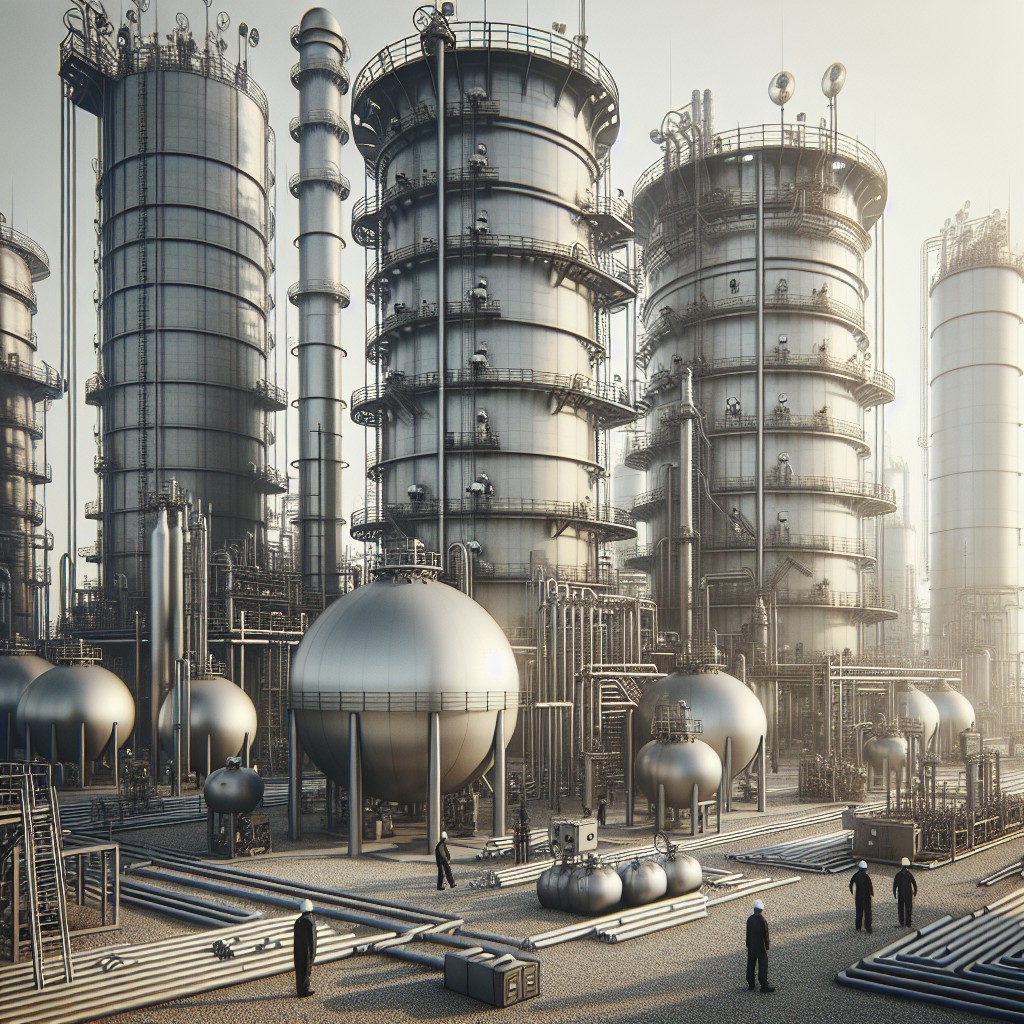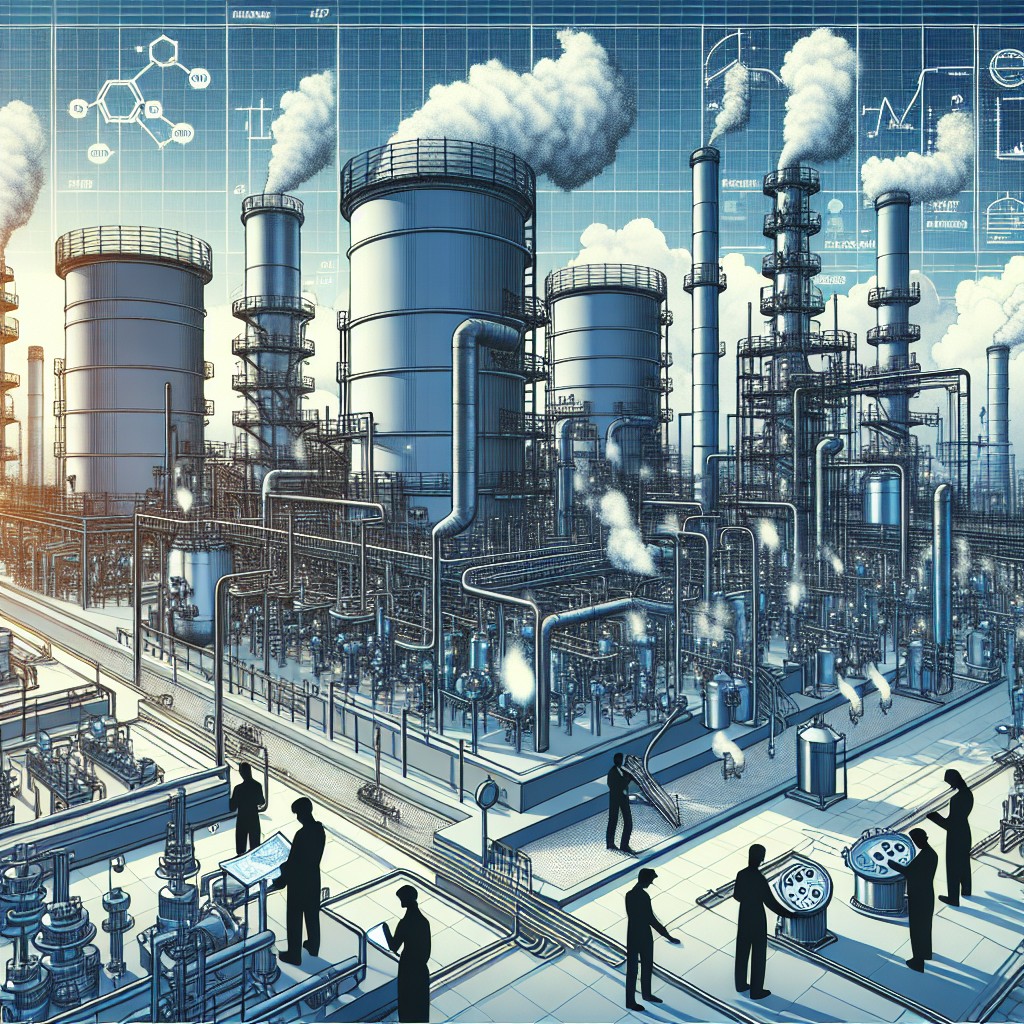Last updated on
Because pressure vessel design is a pivotal aspect of many industries, understanding its fundamentals can genuinely enhance your productivity and safety on projects.
Dive into the world of pressure vessel design—a fascinating nexus of engineering prowess and industrial necessity. Whether these robust containers are assuming the classic contours of cylinders or embracing the spherical simplicity, their role is pivotal in managing the formidable forces of internal and external pressures.
Beyond their striking silhouettes, pressure vessels boast an arsenal of safety mechanisms, such as safety valves and rupture disks, essential for faultless operation. The choice of construction materials goes far beyond mere strength; these vessels withstand corrosive chemicals, searing heat, and crushing pressures.
From the depths of oil wells to the precision of pharmaceutical labs, pressure vessels are the unsung heroes of multiple industries. Prepare to uncover the intricacies and innovations that make these industrial companions the backbone of critical sectors worldwide.
Key takeaways:
- Enclosures: Pressure vessels come in varied shapes, typically cylindrical or spherical.
- Pressure Differential: Precision engineering is required to handle high internal or external pressures.
- Safety Features: Equipped with devices like safety valves and rupture disks.
- Construction Materials: Fabricated from materials capable of withstanding corrosive substances, extreme temperatures, and pressure.
- Industry Companions: Integral in industries such as oil and gas, chemicals, power generation, and pharmaceuticals.
Table of Contents
Defining Pressure Vessels: A Brief Overview

Pressure vessels are enclosed containers designed to hold gases or liquids at a pressure substantially different from the ambient pressure. Their robust construction enables function across a variety of industries, serving as storage tanks, heat exchangers, chemical reactors, and more.
Enclosures: They come in varied shapes—typically cylindrical or spherical—to uniformly distribute pressure, reduce weak points, and minimize material use.
Pressure Differential: High internal or external pressures demand precision engineering to ensure integrity and safety.
Safety Features: Equipped with devices like safety valves and rupture disks to prevent catastrophic failure.
Construction Materials: Fabricated from materials capable of withstanding corrosive substances, extreme temperatures, and pressure—commonly stainless steel or reinforced composites.
Industry Companions: Integral in industries such as oil and gas, chemicals, power generation, and pharmaceuticals, due to their robust and versatile nature for storage and processing needs.
Understanding these key points lays the foundation for delving deeper into design specifics and industry applications.
Importance of Pressure Vessels in Modern Industry

Pressure vessels are integral to industrial operations across a vast array of sectors. Here are some key points that highlight their significance:
- Energy Production: They’re crucial in power plants, where they’re used in boilers and reactors to produce steam and store gases at high pressures necessary for energy generation.
- Processing Industries: The chemical, petrochemical, and oil industries rely on them to store and process a variety of fluids and gases under controlled conditions, ensuring both safety and efficiency.
- Pharmaceutical Sector: In pharmaceuticals, pressure vessels are essential for autoclaves and fermentation processes, requiring precise pressure control for sterilization and cultivation of microorganisms.
- Food and Beverage Industry: Carbonation tanks for sodas and storage vessels for processed foods exemplify their application in preserving quality and ensuring food safety standards.
- Aerospace: Pressure vessels are tasked with holding gases used in propulsion and life support systems in spacecraft, where reliability is not just crucial, it’s life-dependent.
These examples illuminate why pressure vessels are considered the workhorses of the modern industry, with their design and integrity being pivotal to operational safety and efficacy.
Pressure Vessel Design Process
When embarking on the design of a pressure vessel, the steps taken set the stage for both performance and safety. Initially, the process involves a robust analysis of the application’s needs, taking into account factors such as the medium being stored or processed, operating temperatures, and pressures. With this information, engineers select the appropriate materials, ensuring they can withstand the stresses and corrosion potentially faced in service.
Next, determining the vessel’s optimal shape and size is crucial for space efficiency and meeting capacity requirements. Common shapes include cylindrical and spherical structures, each with its own benefits in terms of distribution of stress and internal volume.
Design calculations come into play to ensure structural integrity. These calculations cover wall thickness, weld joint efficiency, and the necessary reinforcements at points where fittings and nozzles integrate into the vessel. Addressing these areas reduces the risk of failure points in the vessel’s structure.
The design process also incorporates the creation of detailed drawings and blueprints. These documents enable precise manufacturing and serve as a guide for inspections and quality control throughout fabrication.
Throughout each step, compliance with local and international standards, especially those set by the American Society of Mechanical Engineers (ASME), ensures that the design meets the highest safety and quality criteria. These standards also facilitate the vessel’s acceptance and certification by regulatory bodies.
In essence, the pressure vessel design process melds analytical precision with regulatory compliance to produce safe, efficient, and reliable vessels tailored to meet specific industrial demands.
Considerations for Selecting Pressure Vessel Design
When selecting a pressure vessel design, pay close attention to operating parameters such as maximum operating pressure and temperature. These directly influence the thickness and material grade required to withstand the conditions without failure.
Material compatibility with the contents is crucial to prevent corrosion or degradation that could lead to leaks or contamination. For instance, stainless steel might be selected to store corrosive fluids, while carbon steel could suffice for non-corrosive applications.
Volume and size constraints of the installation site must be factored into the design. Compact designs are necessary for small spaces, yet should not compromise access for maintenance.
Efficiency and cost-effectiveness play significant roles. A well-designed pressure vessel maximizes material use and minimizes waste, thereby reducing overall cost while maintaining safety and performance.
Safety features such as pressure relief valves are integral to the vessel’s design, ensuring it can safely handle unexpected overpressure scenarios.
Lastly, consider future needs, including possible process changes or expansion. A flexible design may offer adaptability to accommodate new requirements without necessitating a completely new vessel.
Materials of Construction for Pressure Vessels
Selecting the right materials is critical when designing a pressure vessel to ensure durability, safety, and cost-effectiveness. Materials must be chosen based on the intended application and must withstand the operational pressures and temperatures.
Here are key points to consider:
- Carbon Steel: This is a common choice due to its cost-effectiveness and high tensile strength. It’s particularly suitable for vessels operating at high temperatures.
- Stainless Steel: Ideal for corrosive environments, stainless steel offers excellent corrosion resistance and strength.
- Aluminum: For applications requiring lightweight vessels, aluminum is beneficial due to its high strength-to-weight ratio and good corrosion resistance.
- Nickel Alloys: When the pressure vessel requires operation in extreme conditions, nickel alloys provide high temperature and corrosion resistance.
- Composite Materials: Modern vessels increasingly turn to composites for their high strength, corrosion resistance, and lighter weight – though cost and complexity may be higher.
- Material Thickness: Selection must also account for the thickness, which is tailored to handle the maximum expected operating pressure.
- Weldability and Fabrication: The material should allow for reliable welding and efficient fabrication to maintain the integrity of the vessel throughout its lifespan.
- Corrosion Allowance: For materials susceptible to corrosion, an extra thickness is included in the design to compensate for material loss over time.
Understanding the operational environment and service conditions will guide the selection process, balancing performance requirements with economic considerations.
Design Loads in Pressure Vessel Design
In creating a secure pressure vessel, understanding design loads is crucial. These represent the different forces that the vessel will need to withstand during normal and extreme operating conditions. Here are a few pivotal components:
- Internal and External Pressure: These are the primary forces, the internal pressure exerted by the contained fluid and external pressures such as atmospheric or those from adjacent structures.
- Temperature-induced Stresses: Fluctuating temperatures cause expansion or contraction, thus affecting the stress on the vessel’s material.
- Dead Loads: The vessel’s own weight, along with attached components, is a constant force that must be accounted for, ensuring structural integrity even when not operational.
- Live Loads: They include forces during maintenance such as personnel and equipment weight, or during operation like fluid movement and sloshing.
- Dynamic Loads: Events like earthquakes, wind, and transportation impose additional stress on the vessel and need special attention in design.
Each of these loads influences the thickness, shape, and material choice for the vessel to assure optimal performance and safety. Advanced computational tools help engineers model and simulate these conditions to fine-tune the design before fabrication.
Adhering to Design Codes and Standards
Adherence to established codes and standards is critical in ensuring the safety, reliability, and governability of pressure vessels. Here are key points:
- Safety Compliance: Codes ensure that designs prioritize safety, preventing structural failures which can lead to catastrophic events.
- Regulatory Requirement: Pressure vessel designers must comply with regulatory codes, often mandated by government bodies, to certify the equipment for use.
- International Standards: Following international norms like the ASME Boiler and Pressure Vessel Code (BPVC) facilitates global operations, allowing the pressure vessels to be accepted and utilized worldwide.
- Best Practices: Design codes represent a culmination of industry best practices and empirical data that help designers create vessels with confidence in their performance.
- Economic Efficiency: Adhering to standards can help in reducing costs in the long term by optimizing the design process and minimizing the risk of failure and subsequent liability.
- Consistency: Uniform design codes ensure consistency in quality across various manufacturers and industries, fostering a predictable level of performance.
- Innovation and Evolution: Codes and standards evolve over time, incorporating new technologies and materials, which designers must stay current with to maintain their knowledge and expertise.
The Role of ASME VIII-1 in Pressure Vessel Design
The American Society of Mechanical Engineers’ (ASME) Boiler and Pressure Vessel Code, Section VIII-1, sets forth criteria for the design, fabrication, inspection, testing, and certification of pressure vessels. It serves as a fundamental guideline engineers worldwide rely on to ensure safety and compliance.
Here’s how ASME VIII-1 shapes the design process:
- Mandatory Standards: Designers must adhere to the precise standards outlined to ensure safety and performance of the vessels under various operating conditions.
- Material Specifications: This code stipulates acceptable materials and their allowable stress, impacting decisions regarding the vessel’s construction.
- Structural Integrity: ASME VIII-1 provides formulas and guidance for calculating wall thickness, reinforcements, and overall stability against internal pressure.
- Safety Features: The code includes requirements for safety aspects like pressure relief devices, ensuring protection against overpressure scenarios.
- Inspection Protocols: It establishes rigorous inspection and testing routines to be followed before a vessel can enter service.
- Certification Process: By meeting the ASME VIII-1 standards, manufacturers can affix the ASME certification mark, signaling compliance to regulators and consumers.
Incorporating these principles into the design and fabrication of pressure vessels promotes widespread safety and operational reliability.
Dual Certified Vessels for Low Temperature Service
Dual certified vessels are engineered to meet stringent standards, ensuring they can operate safely in a variety of temperature environments, particularly low-temperature conditions. The demands of such applications call for materials that are not brittle and can withstand the thermal stress of cold climates without compromise.
Here are key points to consider:
- Material Selection: For low-temperature service, materials with high notch toughness—a measure of a material’s ability to absorb energy and deform without fracturing—are critical. Commonly, metals like ASTM A333 Grade 6 or ASTM A350 LF2 are chosen for their resilience in cold conditions.
- Impact Testing: To ensure suitability, materials are subjected to Charpy V-Notch testing. These tests help to simulate the material’s behavior in low temperatures and ensure it doesn’t fail under impact.
- Design Adaptation: Vessels may need thicker walls to combat the reduced strength and increased brittleness that materials exhibit at low temperatures. This adaptation helps maintain structural integrity.
- Heat Treatment: Post-weld heat treatment is often required to relieve stress concentrations and improve toughness in welded areas.
Considering these points is paramount for the safe functioning of the vessel within the operational range anticipated. Proper adherence to these considerations helps in curating dual certified vessels tailored for exceptional performance in extreme cold service conditions.
Designing for Lethal Service Conditions
When designing pressure vessels that will operate under lethal service conditions, engineers must prioritize the safety and integrity of the vessel. The following points outline the key considerations in such high-stake scenarios:
- Robust Material Selection: Materials must exhibit excellent corrosion resistance and durability to withstand hazardous substances. Nickel alloys and stainless steels are often preferred for their resilience.
- Thickened Walls for Extra Safety: To handle potentially dangerous substances, pressure vessels may require thicker walls than standard designs to prevent rupture and contain toxic or flammable materials effectively.
- Incorporating Safety Margins: Design calculations should include significant safety margins to account for unexpected spikes in pressure or temperature, reducing the risk of catastrophic failure.
- Stringent Testing Protocols: Rigorous testing, including hydrostatic and pneumatic tests, ensures the vessel can safely contain lethal contents even under adverse conditions.
- Advanced Monitoring Systems: Embedding sensors and control systems for real-time monitoring can help quickly detect leaks or performance issues, allowing for immediate action to mitigate risks.
- Emergency Relief Systems: Pressure relief devices must be properly sized and positioned to quickly relieve excess pressure in the event of an emergency, ensuring the vessel does not become compromised.
- Regular Maintenance Schedules: Establishing a frequent inspection and maintenance routine is critical to ensuring the vessel’s integrity over time, especially when handling lethal materials.
Through these focused design strategies, pressure vessels can achieve the necessary safety levels to operate under lethal service conditions, protecting both personnel and the environment.
Latest Innovations in Material Science for Pressure Vessel Design
Material science continually pushes the boundaries of what’s possible in pressure vessel design. Recent innovations focus on enhancing materials’ properties to improve performance, safety, and durability. Here are key advancements:
- High-Strength Steel Alloys: Development of steel alloys with higher yield and tensile strengths allows for thinner vessel walls, reducing weight without sacrificing safety.
- Corrosion-Resistant Alloys: Alloys such as Hastelloy, Inconel, and Monel are being used extensively to extend the life of vessels subject to corrosive environments.
- Composite Materials: The use of carbon fiber-reinforced polymers and other composites offers superior strength-to-weight ratios and corrosion resistance.
- Smart Materials: Introduction of materials with built-in sensors capable of monitoring the integrity of the vessel and providing real-time data to operators.
- Nanomaterials: Research into nanotextured surfaces and nanocomposite coatings aims to further improve corrosion and wear resistance, potentially revolutionizing vessel maintenance.
These advancements enhance the functionality and longevity of pressure vessels, opening up new possibilities for their application in challenging environments.
The Impact of Technological Advancements On Pressure Vessel Design
Technological advancements have revolutionized the way pressure vessels are designed. With the adoption of computer-aided design (CAD) software, engineers can create more precise and complex vessel shapes, optimizing for efficiency and safety. Simulation technology allows for virtual testing under various conditions, reducing the need for costly prototypes and potential design flaws.
Incorporating digital twin technology, designers can simulate the entire lifecycle of a pressure vessel, identifying maintenance needs and extending the vessel’s service life. Advancements in material science have led to the development of new alloys and composites that are stronger and more resistant to corrosion and extreme temperatures.
Robotic and automated welding systems have enhanced the speed and quality of production, resulting in more consistent and reliable vessels. These tools also increase worker safety by undertaking tasks in environments that may be dangerous for humans.
Emerging technologies such as 3D printing are beginning to be utilized for producing complex parts and repair components for pressure vessels, offering a rapid turnaround and reducing downtime.
Overall, these technologies contribute to creating pressure vessels that are safer, more efficient, and longer-lasting, reflecting the ongoing evolution in the field.
Automation and Its Role in Vessel Manufacturing
The advent of automation in manufacturing has streamlined the production of pressure vessels, enhancing precision while reducing labor costs and production time. Advanced machinery, such as computer numerical control (CNC) systems, now perform tasks that once required extensive manual input.
Key Points:
- CNC machines cut, drill, and shape vessel components with high accuracy, minimizing human error.
- Automated welding techniques, like robotic and submerged arc welding, ensure consistent, high-quality seams that are crucial for the vessel’s integrity.
- Inspection processes benefit from automation through advanced methods like automated ultrasonic testing, which can rapidly detect flaws in materials.
- Material handling robots can safely maneuver heavy and hazardous components, reducing workplace injuries.
- Overall, automation contributes to a more efficient design iteration process, allowing for rapid prototyping and adjustments based on precise digital models.
Advances in Non-Destructive Testing (NDT) for Pressure Vessels
Technological advancements continue to revolutionize non-destructive testing (NDT) methods, ensuring that pressure vessels operate safely and efficiently. Ultrasonic testing, for example, has seen significant improvements with phased array technology that can locate defects with greater accuracy and speed. Similarly, digital radiography provides clearer imaging of a vessel’s interior compared to traditional X-ray films, facilitating more precise analysis.
Eddy current testing, used for detecting surface flaws, benefits from enhanced sensitivity and the use of advanced algorithms that help differentiate between critical defects and non-relevant indications. Acoustic emission testing now uses sophisticated sensors capable of picking up sounds of cracks growing under stress, sometimes even before they become visible.
Thermographic inspections are now more reliable with high-resolution infrared cameras and complex software that can detect issues by analyzing temperature differences on the vessel’s surface. This method is particularly valuable for monitoring the degradation of insulating materials over time.
Advancements in data processing have also improved the overall effectiveness of NDT methods. No longer is NDT limited by the ability to record and analyze data; today’s NDT technicians can use powerful software to quickly interpret vast amounts of test results, leading to more timely and informed maintenance decisions. This ever-improving accuracy and efficiency are critical to ensuring the continued safety of pressure vessels across industries.
Regulatory Framework and Standardization of Pressure Vessels
Navigating the intricate regulatory landscape is a vital step in designing and manufacturing pressure vessels. Standards ensure safety, reliability, and operational efficiency across the industry. Key regulations and standardization bodies include:
- The American Society of Mechanical Engineers (ASME): Its Boiler and Pressure Vessel Code (BPVC) is widely recognized and dictates guidelines for design, fabrication, and inspection.
- The Pressure Equipment Directive (PED) in the European Union: This directive harmonizes safety standards across EU member states for the design and manufacture of pressure equipment.
- International Organization for Standardization (ISO): Various ISO standards provide global benchmarks for quality and safety in pressure vessel construction.
Compliance with these frameworks is not just a legal obligation; it also instills confidence in stakeholders and end-users about the vessel’s safety and quality. Manufacturers must diligently adhere to these standards, which often requires engaging with certified inspectors and engineers throughout the design and manufacturing process. Regular updates to codes mean continuous education and adaptation are necessary to remain compliant and competitive.
Future-Oriented Design Techniques for Pressure Vessels
Adopting advancements in computational methods allows for more precise simulations of extreme conditions, leading to safer, more resilient designs. For instance, finite element analysis (FEA) has become instrumental in predicting how materials will behave under various stresses and temperatures.
The integration of smart sensors and the Internet of Things (IoT) is revolutionizing how we monitor pressure vessels. Real-time data collection can now predict maintenance needs and spot potential issues before they become critical, ensuring uninterrupted operation and extending the vessel’s lifespan.
Material innovations, like the use of corrosion-resistant alloys or composites, offer higher strength-to-weight ratios while withstanding harsh environments. This reduces the overall weight, cutting transportation costs, and improves performance in challenging conditions.
Environmental considerations are also shaping future designs. Pressure vessels are being engineered to minimize their carbon footprint, both in terms of manufacturing processes and operational efficiency. The use of cleaner, renewable energy sources as a part of their operation is not only sustainable but also economically favorable in the long run.
Lastly, modular design approaches are catering to the need for flexible manufacturing. These permit vessels to be constructed in sections and assembled onsite, allowing for easier transportation and adaptation to various industrial needs. This modular nature also streamlines any necessary retrofitting or upgrades, aligning with a forward-thinking approach to pressure vessel use.
Design Considerations for Extending Pressure Vessel Lifecycle
Ensuring longevity in pressure vessels hinges on meticulous design. Key factors include:
- Selecting Optimal Materials: Use corrosion-resistant alloys for enhanced durability.
- Stress Analysis: Employ finite element analysis to predict stress points and mitigate fatigue.
- Thickness and Reinforcement: Opt for thicker walls or reinforcement at critical areas to withstand operational stresses better.
- Corrosion Allowance: Include extra material thickness to account for future corrosion, thus extending service life.
- Proper Welding Techniques: Utilize advanced welding methods that reduce the risk of defects and ensure stronger joints.
- Designing for Overpressure Protection: Incorporate safety features like pressure relief valves to prevent overpressure scenarios.
- Facilitating Inspections: Design with accessibility in mind for regular maintenance and inspection, which can prevent long-term issues.
Adherence to these points will contribute to a pressure vessel’s longevity and performance, ensuring safety and efficiency.
Safety Challenges and Solutions in Pressure Vessel Design
Ensuring the safety of pressure vessels is paramount due to the high potential risk associated with their operation. Among the myriad of challenges, a few stand prominent:
1. Corrosion: Over time, chemical reactions can degrade vessel material. To combat this, corrosion allowance is built into the design, and anti-corrosive coatings or choosing corrosion-resistant materials are often employed.
2. Overpressure: A vessel might experience internal pressures exceeding design limits. Relief devices such as safety valves are installed to release excess pressure and prevent catastrophic failure.
3. Temperature Extremes: Materials expand or contract with temperature changes, which can stress the vessel’s structure. Thermal analysis leads to designs that can withstand the thermal cycles experienced during operation.
4. Cyclic Loading: Repetitive stress from pressure fluctuations, known as fatigue, can lead to cracks. Detailed fatigue analysis helps ensure that the vessel can handle the expected number of cycles during its lifespan.
5. Seismic Activity: In earthquake-prone areas, vessels must be designed to withstand seismic loads. This involves rigorous structural analysis and the implementation of features such as flexible connections and seismic restraints.
6. Improper Operation: Human error is a potential safety issue. Designing for a margin of safety and implementing fail-safes, along with thorough training for operators, minimizes risks.
By addressing these challenges proactively, designers can enhance the safety and reliability of pressure vessels, safeguarding both personnel and the environment.
The Importance of Comprehensive Design Analysis in Pressure Vessels
In assessing pressure vessel integrity and performance, a meticulous design analysis stands as the cornerstone. Here’s why:
- Safety Assurance: Evaluating potential failure points and stress areas ensures the vessel can withstand operating conditions without posing hazards.
- Cost Efficiency: A thorough analysis guides material selection and thickness, preventing over-engineering and unnecessary expenditure.
- Regulatory Compliance: By factoring in design codes during analysis, designers guarantee that the vessel adheres to legal and safety standards.
- Optimized Performance: Considering factors like thermal expansion and corrosion rates, analysis is pivotal to predict and enhance the vessel’s long-term functionality.
- Innovation Support: Advanced analysis tools assist in integrating new materials and technologies, fostering innovation while maintaining reliability.
Understanding these points underscores why skipping design analysis isn’t just imprudent—it compromises the project’s very foundation.
FAQ
How to design a pressure vessel?
Designing a pressure vessel involves determining the maximum allowable working pressure, taking into account factors like temperature, material properties, and the type of fluid or gas being stored.
What is the best shape for a pressure vessel?
The best shape for a pressure vessel is spherical, as it has approximately twice the strength of a cylindrical pressure vessel with the same wall thickness and is ideal for holding internal pressure.
What is the most common design of pressure vessel?
The most common design of pressure vessel is the cylindrical shape due to its versatility and cost-effectiveness.
What materials are best suited for constructing a pressure vessel?
The ideal materials for constructing a pressure vessel include carbon steel, stainless steel, and alloy materials due to their strength, durability, and resistance to pressure and temperature variations.
How do safety standards influence pressure vessel design?
Safety standards greatly influence pressure vessel design by determining materials, manufacturing processes, and testing methods to ensure safe and durable operation.
What are the key considerations in calculating the wall thickness of a pressure vessel?
The key considerations in calculating the wall thickness of a pressure vessel involve factors such as internal pressure, vessel diameter, material strength, and safety considerations.




